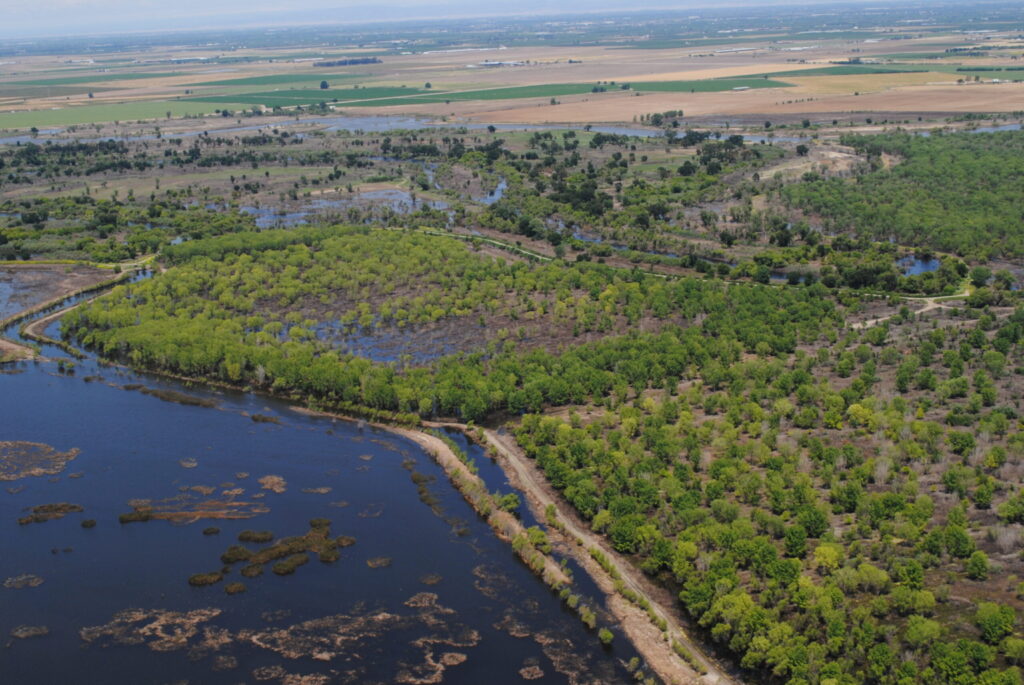The state approved funding for a range of floodplain projects in the San Joaquin Valley, clearing the way for work to potentially begin as soon as this week.
The state budget included $40 million for floodplain restoration projects in the San Joaquin Valley, which would let rivers spread out over large swaths of undeveloped land to slow the flow and absorb the water.
On August 24, the California Wildlife Conservation Board voted to spend $21 million of the funding which will be doled out to six on-the-ground projects and 10 planning projects, all overseen by the nonprofit River Partners. The rest of the money will be voted on in November at another board meeting and is proposed for two land acquisitions.
The planning projects will include permitting, monitoring and research across 10 floodplain sites on the San Joaquin River, its tributaries and the lower Kern River. It will include planning for at least 3,000 acres of floodplain restoration. All board members voted to approve this portion of the funding.
Part of the on-the-ground proposal included restoration and maintenance of more than 400 acres of wildlife habitat along the San Joaquin River in Stanislaus County. All of the locations fall within the disadvantaged communities of Dos Rios, Grayson and Crows Landing, which have struggled with drinking water access and contamination, according to a presentation given at the board meeting. The funding will pay for repairs to infrastructure that was damaged in this year’s storms. It will also pay for the removal and cleaning of former dairy infrastructure.The project will restore native habitat and reduce nearby communities’ exposure to chemicals over time.
Some of this work had already been done but was wiped out by the recent floods. Board members questioned why.
Julie Rentner, president of River Partners, explained that floodplain restoration projects need three years to be established. Because vegetation that was planted was less than 12 months old, floods wiped out the small plants.
“Yes, finding ways to establish this vegetation, these restored floodplains faster, is important,” said Rentner at the meeting. “But we did just come off of a six year period of no water on these fields, which was perfect for establishment of vegetation. So it’s a challenge of floodplain restoration to get all the timing right.”
The board approved the funding but board member Kathryn Phillips abstained from the vote and spoke against the use of herbicides in the plan.
The final piece of funding which was presented to the board was a project to remove a minimum of 100 acres of Arundo, an invasive plant, in Madera County waterways. Arundo is a water intensive plant that has choked floodplain functionality.
The project will be accomplished using herbicides and mechanical removal.
Some commenters and board members pushed back against the use of herbicides.
Rentner said alternatives to herbicides were far too costly and time consuming, putting nearby communities at risk. The Arundo not only increases risk of wildfires but causes flood control channels to function improperly and causes erosion of existing levees.
“Yes, of course we can take our time and do this with only mechanical methods,” said Rentner at the meeting. “But the risks and the outcomes associated with taking our time and doing it only mechanically are lives, communities, not just wildlife.”
Board member Phillips abstained again but the funding was still approved by the majority of the board.
“I find it personally offensive, that there’re people who sit in Sacramento and say, ‘what if we threw a bunch of money at the problem to do solutions ineffectively?’ Those are our tax dollars,” Rentner told SJV Water in an interview. “And then second of all, what you’re proposing is not simply spend more money, it’ll also be inefficient.”
Improperly maintained waterways have led to severe flooding, Rentner added. In Planada, a small community in Merced County, was hit hard by flooding in January partly because the nearby levee broke due to lack of maintenance and being clogged with Arundo, she said.
“If we get another series of storms this year, and the system is stressed again that way and we haven’t been able to get any of that channel clearing work done, who knows where the next break is going to be?” said Rentner.
For some of the projects that were approved, everything is ready to go and work could begin this week, said Rentner. There are a few tweaks on a grant agreement for one portion of the approved projects which should be completed in the coming weeks, she said.
The $40 million has a sunset of June, 2026.
“Time is of the essence getting out there to get all this work done,” said Rentner. “Before the funds turn to pumpkins.”
Share this:
- Click to share on Facebook (Opens in new window)
- Click to share on Twitter (Opens in new window)
- Click to share on LinkedIn (Opens in new window)
- Click to share on Reddit (Opens in new window)
- Click to share on Tumblr (Opens in new window)
- Click to share on Pinterest (Opens in new window)
- Click to share on Pocket (Opens in new window)
- Click to share on Telegram (Opens in new window)
- Click to share on WhatsApp (Opens in new window)
- Click to print (Opens in new window)








